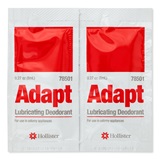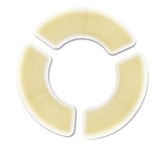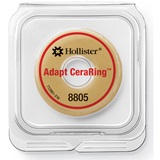Summertime Care for Children with Ostomies
Are you a caregiver for a child with an ostomy? In the summer months, this can become more challenging, thanks to heat, humidity, water activities, and travel plans.

Get helpful advice to care for the littlest people with an ostomy
By Teri Coha MSN, CWON
Summertime brings warmer temperatures and fun in the sun! It may also bring new experiences for someone living with or caring for an ostomy. Here are some questions I am asked by parents who are caring for their child with an ostomy. These suggestions apply to adults as well.
For all summer activities, anyone wearing a one-piece pouching system style (the barrier and pouch are one piece), may want to consider a two-piece pouching system (barrier and pouch are two separate pieces). Playing on the beach or traveling by air? No need to find a bathroom, use a port-a-potty, or empty a pouch in a small airplane bathroom.
It takes some time to get different supplies and try them before your travel or activity, so plan in advance. Call your Hollister Secure StartSM services representative to get some samples to try, and allow enough time to get supplies from your medical supply company.
Q: We are traveling for vacation this summer! What should I pack for my child with an ostomy?
A: An ostomy should not prevent any form of travel for your family. Below are tips to keep your vacation fun.
I am always the one who brings too much on vacation and often brings unused clothing home. But I never regret being prepared. When it comes to ostomy supplies, create an ostomy travel kit and bring twice as much as you would normally use for the days you will be away from home. No one wants to spend part of their vacation searching for a supplier in the area or having supplies shipped to their hotel…or tent. You might bring all the extras home, but it is definitely better than the alternative.
Remember to keep your child’s supplies in a cool area at all times so they do not melt. If you are traveling by car, consider storing them in a cooler with ice. A cooler also works well if you are camping.
If you are flying, keep all your supplies in your carry-on luggage. Shortly before boarding the plane, empty the pouch and add some lubricating deodorant to help reduce odor when you empty or change your pouch or more easily empty the contents of your pouch. Be sure to carry on small packets or a travel size bottle of lubricating deodorant so it is not confiscated.
Q: Warm weather is here – time to break out the shorts and sandals! Are there any clothing considerations for my child with an ostomy?
A: Children don’t necessarily need any special clothes or ostomy swimwear. However, a few items may help keep them more comfortable. Rash guards or swim shirts – the ones that fit snugly – are great for keeping the pouch close to the body. Layering t-shirts is certainly a fashion trend, so if your child likes something looser, wearing a simple cotton loose-fitting top over the snug one works well.
If you or someone you know has a sewing machine and can sew some simple seams, swimwear fabric is inexpensive and available at stores that sell fabric. Bands made out of swimwear are cool and comfortable, and will hold the barrier in place. Pre-made ostomy swimming belts are also available.
Finally, the Internet is full of people who make pouch covers for children. Find his or her favorite.
Q: Summer is a time for cookouts and campfire treats. Are there any dietary considerations for my child with an ostomy?
A: Dietary changes can be challenging on any vacation. Try to stick with foods that don’t affect stool output or at least limit the ones that cause an increase in output or an increase in gas. It will be tempting to allow more sweets and high sugar beverages, but these can lead to looser stools.
Warm temperatures and outdoor activities increase everyone’s need for fluids, especially a child with an ileostomy. Many beverages are strong if made according to the directions. Diluting them will increase water intake while still providing flavor, as well as some sugar and electrolytes that they may need.
Fast food restaurants are convenient when traveling, but if your child is not used to eating those foods, he or she may experience increase in gas or stool output. Bring foods along that your child eats at home and limit the number of foods not eaten regularly.
Q: My family loves to spend time at the lake or pool in the summer. Any suggestions regarding swimming with an ostomy?
A: Again, plan ahead. Knowing the “wear time” or the usual length of time of your child’s pouching system stays in place will help. Swimming toward the end of his or her usual wear time is not a good idea. Immediately after a pouch change may also not work as the barrier may not have fully adhered to the skin. If you are going to swim first thing in the morning, try changing the pouching system before your child goes to bed. Always empty the pouch just before swimming and frequently while swimming.
Test out the pouching system in water before a swimming outing by having your child play around in the bathtub with his or her pouching system on. Another option would be to add a barrier ring to help extend wear time and/or barrier extenders around the edges of the barrier.
Q: My child is going to a sleepover event. Any suggestions?
A: Your child should only go on a sleep over if they are old enough to manage their own stoma care, including emptying and changing the pouch. While sleepovers are great activities and every child wants to experience them, the fun may be ruined by an embarrassing situation.
The parents of the family he or she is staying with need to be aware that your child has an ostomy and be comfortable helping your child if needed. Your child may also have dietary preferences that will require some advance planning. If your child has foods they have to avoid, make sure they have foods they can eat. They should have enough to share so they don’t feel different.
Q: Summer weather can be hot and humid! Is there anything specific I should be doing to help take care of my child’s peristomal skin?
A: Barriers may melt quicker in hot weather, requiring more frequent pouch changes. If your child is using a standard wear barrier, an extended wear barrier may be helpful. It is designed to be more resistant to break down. However, insurance companies may not cover as many extended wear barriers. It may be easier to add an extra layer around the stoma with a barrier ring, and around the barrier edges with barrier extenders.
If your child develops a rash, contact your healthcare provider. A fungal rash would need to be treated with medicated ostomy powder and possibly oral medications.
For more information, contact Hollister Secure StartSM services at 1.888.808.7456 or visit www.securestartservices.com.
Prior to use, be sure to read the Instructions for Use for information regarding Intended Use, Contraindications, Warnings, Precautions, and Instructions.
Teri Coha MSN, CWON is a pediatric nurse at Ann & Robert H. Lurie Children’s Hospital of Chicago, Illinois USA with more than 35 years of experience. Her practice has focused on the care of infants, toddlers, and teens with ostomies.
Financial Disclosure: Teri received compensation from Hollister Incorporated for her contribution to this article.
- 3 Shares
- 15 Recommended





 Call Us
Call Us  Email Us
Email Us  Join Us!
Join Us!  Sign Up
Sign Up 